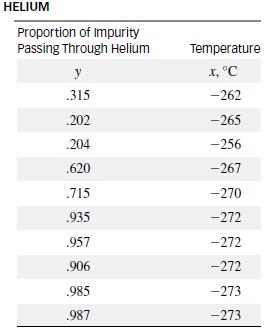At temperatures approaching absolute zero (273 degrees below zero Celsius), helium exhibits traits that defy many laws
Question:
At temperatures approaching absolute zero (273 degrees below zero Celsius), helium exhibits traits that defy many laws of conventional physics. An experiment has been conducted with helium in solid form at various temperatures near absolute zero. The solid helium is placed in a dilution refrigerator along with a solid impure substance, and the proportion (by weight) of the impurity passing through the solid helium is recorded. (This phenomenon of solids passing directly through solids is known as quantum tunneling.) The data are given in the table.

a. Construct a scattergram of the data.
b. Find the least-squares line for the data and plot it on your scattergram.
c. Define β1 in the context of this problem.
d. Test the hypothesis (at α = .05) that temperature contributes no information for the prediction of the proportion of impurity passing through helium when a linear model is used. Draw the appropriate conclusions.
e. Find a 90% confidence interval for β1. Interpret your results.
f. Find the coefficient of correlation for the given data.
g. Find the coefficient of determination for the linear model you constructed in part b. Interpret your result.
h. Find a 99% prediction interval for the proportion of impurity passing through helium when the temperature is set at -270°C.
i. Estimate the mean proportion of impurity passing through helium when the temperature is set at -270°C. Use a 99% confidence interval.
Step by Step Answer:

Statistics For Engineering And The Sciences
ISBN: 9781498728850
6th Edition
Authors: William M. Mendenhall, Terry L. Sincich





